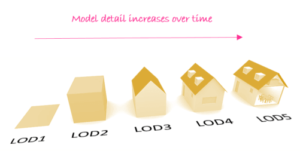BIM (Building Information Modeling) is a digital process that involves creating and managing 3D models of buildings and infrastructure. The level of detailing in BIM can vary depending on the stage of the project and the intended use of the model.
There are four recognized levels of detailing in BIM, known as LOD (Level of Development) or LOI (Level of Information). These levels are:
LOD 100/LOI 100: Concept Design
LOD 100 (Level of Development 100) is the lowest level of detail in BIM (Building Information Modeling) that represents the initial phase of a project’s development. At this level, the model is basic and provides a rough idea of the building’s size, shape, and orientation. The model is typically created during the concept design phase of a project and is used to explore design options and communicate the project’s overall form.
The LOD 100 model typically includes only the most basic information such as the footprint of the building, its orientation, and overall massing. The model may also include basic site information, such as topography, but the level of detail is limited to conceptual massing and does not include specific building components or systems.
The LOD 100 model is typically used to provide an initial visualization of the project to stakeholders, including clients, architects, and engineers, and to help establish the project’s design goals and constraints. As the project progresses, the model’s level of detail is increased, and additional information is added to support decision-making and construction activities.
LOD 200/LOI 200: Schematic Design
LOD 200 (Level of Development 200) or LOI 200 (Level of Information 200) represents the next level of detail in BIM (Building Information Modeling) after LOD 100. At this level, the model begins to include more detailed information about the building’s design and components, and it provides a more accurate representation of the building’s layout and the relationships between its elements.
The LOD 200 model is typically created during the schematic design phase of a project, where the design team explores various design options and establishes the project’s overall design direction. The model includes more detailed geometry, such as walls, doors, and windows, and may also include basic information about the building’s systems, such as HVAC and lighting.
In addition to geometry, the LOD 200 model may also include basic data such as square footage, room names, and general notes. This level of detail is useful for analyzing the building’s spatial relationships and for presenting the design to stakeholders for review and approval.
The LOD 200 model is also useful for identifying potential design issues, such as clashes between building components, and for generating basic quantity takeoffs and cost estimates. As the project progresses, the level of detail is further increased in subsequent LODs to support construction and operations.
LOD 300/LOI 300: Design Development
LOD 300 (Level of Development) and LOI 300 (Level of Information) are terms used in the field of Building Information Modeling (BIM) to describe the degree of detail and accuracy in the design and construction process.
LOD 300 specifically refers to the level of development of a BIM model during the design development phase. This means that the model contains a higher level of detail than LOD 200, which is typically used during the schematic design phase. LOD 300 models are typically used for detailed design, construction documentation, and coordination with other disciplines.
LOI 300, on the other hand, refers to the level of information in a BIM model during the design development phase. This means that the model contains more specific information about the building components, such as their size, shape, and material properties, than LOI 200, which is typically used during the conceptual design phase. LOI 300 models are typically used for estimating, scheduling, and coordination purposes.
In summary, LOD 300 and LOI 300 are used during the design development phase to create more detailed and accurate BIM models that can be used for construction documentation, coordination, estimating, and scheduling.
LOD 400/LOI 400: Construction Documentation
LOD 400 (Level of Development) and LOI 400 (Level of Information) are terms used in the field of Building Information Modeling (BIM) to describe the degree of detail and accuracy in the construction documentation phase.
LOD 400 specifically refers to the level of development of a BIM model during the construction documentation phase. This means that the model contains an even higher level of detail than LOD 300, with additional information about how the building components are put together and how they will be installed. LOD 400 models are typically used for construction documentation and coordination, as well as for fabrication and assembly of building components.
LOI 400, on the other hand, refers to the level of information in a BIM model during the construction documentation phase. This means that the model contains even more specific information about the building components than LOI 300, including detailed specifications, installation instructions, and manufacturer information. LOI 400 models are typically used for fabrication, assembly, and installation purposes.
In summary, LOD 400 and LOI 400 are used during the construction documentation phase to create highly detailed and accurate BIM models that can be used for construction documentation, fabrication, assembly, installation, and coordination purposes.
It’s important to note that the level of detailing in BIM is not a one-size-fits-all solution and can vary depending on the project’s needs. For example, a project with a tight construction schedule may not require an LOD 400 model, while a complex project may require an LOD 500 model for post-construction maintenance and operations.
LOD 500/LOI 500: As Build
LOD 500 (Level of Development) and LOI 500 (Level of Information) are terms used in the field of Building Information Modeling (BIM) to describe the highest degree of detail and accuracy in the design and construction process, which is achieved during the as-built phase.
LOD 500 specifically refers to the level of development of a BIM model during the as-built phase. This means that the model contains the highest level of detail, accuracy, and completeness, including all necessary information required for maintenance and operation of the building. LOD 500 models are typically used for asset management, facility management, and maintenance purposes.
LOI 500, on the other hand, refers to the level of information in a BIM model during the as-built phase. This means that the model contains the most comprehensive and accurate information about the building components, including their exact location, dimensions, and condition. LOI 500 models are typically used for facility management, maintenance, and retrofitting purposes.
In summary, LOD 500 and LOI 500 are used during the as-built phase to create the most detailed and accurate BIM models that can be used for asset management, facility management, maintenance, and retrofitting purposes.



4 Responses
Can I simply say what a relief to uncover somebody that truly understands what they are discussing over the internet. You certainly know how to bring an issue to light and make it important. A lot more people must look at this and understand this side of your story. I was surprised that you are not more popular given that you most certainly have the gift.
When I initially left a comment I seem to have clicked on the -Notify me when new comments are added- checkbox and from now on every time a comment is added I recieve four emails with the exact same comment. Perhaps there is a means you can remove me from that service? Kudos!
Good post. I learn something totally new and challenging on blogs I stumbleupon on a daily basis. Its always useful to read content from other authors and practice something from their websites.
I like what you guys are up too. Such clever work and coverage!
Keep up the terrific works guys I’ve added you guys to
my own blogroll.